
- News & Views
- Boats & Gear
- Lunacy Report
- Techniques & Tactics

CRUISER-RACER CONFUSION: Scow Bow Revolution 29 and Gunboat G4 Capsize
This is something I ask myself quite often: can a modern truly cutting-edge high-performance racing sailboat also be a cruising boat? In certain ways, of course, the old ideal of the true cruiser-racer, per the glory days of the Cruising Club of America rating rule and boats such as Carleton Mitchell’s famous yawl Finisterre , evaporated many decades ago. Yet still it is an ideal that both boatbuilders and boat owners incessantly aspire to somehow realize in a modern context, and it is fascinating to watch how these aspirations manifest themselves. Take, for example, the Revolution 29 (see image up top), a new cruising design developed in France that is directly based on David Raison’s radical scow-bowed Mini 6.5 in which he won the Mini Transat in 2011.
Raison’s Mini was not just radical in appearance; it was radically fast and won the 2011 Transat by a large delta, setting a new course record in the process. This success was so significant that other important monohull racing classes—Open 60s, Class 40s, TP 52s—pretty quickly banned scow bows for fear their existing fleets would instantly be rendered obsolete. Development of the concept continues however within the Mini class, which has long been a leading hotbed of high-performance monohull sailing innovation.
David Raison arrives in Brazil aboard TeamWork Evolution in 2011 after crushing the rest of the Mini fleet
What’s interesting about the scow bow, of course, is that it is one of those few racing innovations that immediately and obviously has critical advantages in the cruising market. As in: if you make the bow of any boat much wider you have lots more space inside for accommodations.
Interior of the Revolution 29. A whole lot of space for a boat this small. Note there is also a predecessor design, the Revolution 22, more directly based on the 22-foot racing Mini
But putting a scow bow on a cruising boat obviously doesn’t instantly make it a “cruiser-racer.” What makes the scow bow super-competitive is that it facilitates a boat’s ability to plane, and the other key factor in that equation is always weight. Or rather the lack of it. Load up a boat with lots of furniture and gear and you will seriously inhibit its ability to plane regardless of what shape its bow is. As always, a certain balance must be achieved and compromises must be made.
To get an idea of what a competitive scow-bow boat looks like under sail, watch this viddy here of TeamWork Evolution drag-racing against a conventional Mini.
You should note in particular the boat’s insanely huge sail plan. Prototype Minis are renowned for these, and obviously the rig on any reasonable cruising boat would want to be quite a bit smaller. One question in my mind is whether you in fact need all the extra sail area to make the scow bow fast. Could it be that with more cruiser-sized sails the scow bow might actually be slower than a conventional bow?
The new G4 does its flying thing
Another question being openly discussed right now, thanks to Gunboat and its new G4 foiling catamaran , is whether foils make any sense on a “cruiser-racer.” As I mentioned in my previous post on the boat, it is the first fully foiling boat with any sort of accommodations, and Gunboat has been marketing it as a coastal cruiser-racer. And now in its racing debut at St. Bart’s the svelte little beast has capsized in dramatic fashion, which has prompted some forum trolls as well as a few otherwise polite people to wonder out loud how this could possibly be termed a cruising boat.
Wipe Out from Gunboat on Vimeo .
Watch the viddy here first and then ask yourself: did the boat capsize because it was foiling, or did it capsize because the crew was unable to release the mainsheet for some reason? To me it definitely looks like the latter and that this would have happened, given the issue with the sheet, to any performance cat whether it was airborne or not.
Actually in this image it looks like that helicopter might have been a precipitating cause
Gunboat CEO Peter Johnstone, post flip
So maybe we shouldn’t be focussing on the foils so much. After all, as I understand it the G4 was originally developed as a straight performance cat and the flying foils were added later in the process. Like the AC72s in the last America’s Cup go-round, the G4 wasn’t born a foiler, but evolved into one. Also, of course, it is perfectly obvious that the boat capsized because it was being raced and not cruised. The crew was pushing the boat to its limits, and just because it has a limit (like any boat) doesn’t mean it can’t be cruised. For example, I have a friend who once owned a heavy full-keeled Tayana 37 that was dismasted during a distance race because he declined to take his spinnaker down when conditions got strong. The spinnaker in a gust just pulled the mast right off the boat. Which obviously doesn’t mean you can’t go cruising in a Tayana 37.
I think the real question to ask is: is there a point at which a boat becomes too performance-oriented to really be termed a cruiser? Which really is just another way of asking: what exactly is a cruiser-racer?
Back in the days of Carleton Mitchell and the very conservative CCA rule it was a pretty simple concept. A cruiser-racer was a boat designed to cruise that you could also race, and basically all you had to do to do that was take a ton of crap off the boat and—if you were very serious—bend on different sails. Back in those salad days, that was all it took to be competitive at the highest levels of racing.
These days there are many more variations of the species. There is a vast universe of older boats racing mostly under the PHRF rule in local beer-can series that are very obviously cruising boats that are being raced just for fun. We have a few what I call “captive venues,” the best example being Swans, where there is a small universe of very active racing focussed usually around a brand, where an honest-to-God cruising boat can engage in some pretty serious racing with other cruising boats. We have fancy expensive “performance cruisers” with luxurious interiors that can be raced if desired with minimal changes to the boat (this is pretty much the category the larger Gunboat cats fall into). We have a few even more insanely expensive performance cruisers with wholly interchangeable interiors for both cruising and racing. (I have even seen boats with interchangeable keels!) We have various folding trimarans with cramped accommodations that can be raced in various events. We have families with small children cruising around the world in modified open-class ocean racers. We have “buckets” where enormous super-yachts, obviously designed for cruising in the most obscenely opulent sense of the term, can race against each other.
And on and on and on. The market for sailboats that can be both raced and cruised has become so complex and variegated it is impossible to say where it begins and ends.
Really the only advice I can give to help make sense of this spectrum is that the terms “cruiser-racer” and “racer-cruiser” should not be used interchangeably. Rather we should agree on two specific definitions. As in a cruiser-racer is a boat designed to cruise that can also be raced, and a racer-cruiser is a boat designed to race that can also be cruised.
The G4 I think is certainly a racer-cruiser, and perhaps to some it is an extreme example, but I for one would be very happy taking it out for a week’s worth of high-octane gunkholing.
IN OTHER DEVELOPMENTS: There’s some buzz on the Sailing Anarchy forums that the Gunboat 55 Rainmaker , abandoned after being dismasted back in January , has been spotted again, afloat, but with her coachroof torn away (remember, this is an open-bridgedeck boat, the roof is merely shelter). There’s even one guy claiming the boat has been towed in somewhere, but so far there’s no confirmation of this. I have heard confirmation of the boat’s being spotted, and of the damaged coachroof, from the boat’s designer Nigel Irens via third parties.
Related Posts

- SAILGP 2024 NEW YORK: Lifestyles of the Rich and Famous

CRAZY CUSTOM CRUISING BOATS: New Rides for Pete Goss and Barry Spanier
The scow bow helps the boat surf, especially sailing off the wind. But how is it beating into steep seas?
@Damon: That is the question, for sure. Even if it’s still fast to windward, I bet it’s not exactly comfortable. One advantage of the shape is the waterline area is likely very symmetrical when the boat is heeled, but I guess the bow must pound something fierce.
I think the answer to your question is, yes.
This type of fast – cruising, would be different than what cruising has evolved into since the Finessterre days.
Today, cruising can mean a life choice/commitment of living for decades on a sailboat. The cruising sailboat that must serve as a home at sea has evolved into a complicated and commodious(and expensive), vessel.
To cruise in a high performance boats like you’ve posted, means going light. Backpacking as compared to RV-ing. The speed could be a whole new adventure and lure for younger sailors. But it will come at a cost of comfort and maybe will become less of a time commitment, as back packing is(not many backpack open-ended, for decades).
It appears less people today are jumping into the life choice cruising mantra of the 60’s and 70’s. Yet sailing is as popular as ever with young and old(around me).
I see this notion of a lighter, smaller, faster(cheaper), sailboat on a ‘sail’, as having appeal to a new generation of sailors my kids(and their friends) age, as they grow into a life(and the means), that includes sailing.
Speed is good and will take skill to tame(I love 4kts)!
I have cruised and raced my light, go fast boat for 25 years, loved every minute.
I am drawing a 42′ idea, 14′ beam, looking at 10-12 as a good speed for us elders (me 69, she 66). assy lee boards, unstayed rig, two winches, lots of hatches and deck openings. I built an Atkin Ingrid in 1969-74 and sailed her from San Fran to NZ. As a sailmaker who raced 5O5 at WC level for awhile, the slowness and poor performance upwind of that double ender shape was always tough to trade for some speed. not to mention low and wet. When i hitched a ride from Tahiti to Maui on a Cal 39 it really showed me how nice the speed could be for comfort as well. Better wave synch etc.
thirty years of windsurfing speed and early foiling tri’ experience (Longshot) leave a deep impression about how fast we can go… but 10-12 will do for this stage of my ocean travel dreams. plus, samantha isn’t comfortable with the whole concept yet. got to make it comfy. our Westsail 42 is growing on her, and she’s getting used to that scale of living aboard .
thus, i’d love to hear from anyone who has had some experience with these shapes in head seas. i’m right there with the french concept. so happy to let them find out these things before my paper becomes a boat.
bob johnstone sailed the grot baer across oceans. he probably wasn’t in a hurry. but he must have been comfy enough. if you are truly voyaging, and not sight seeing on a plan, you rarely need to go to weather. it’s a choice. you just have to be flexible about destination and time, no schedules. with today’s weather magic on the net there is even more choice of routing underway for comfort… as long as you are more about the voyage than the destination. obviously i approve of aimless wandering… and have a wife who loves the easy sailing, hates the other bit, and is willing to just be out there,
if that is what it takes to bring her on board happily, i’m on with it. it’s all a bunch of compromises, for senior citizens like us to be voyaging viable for another bunch of years, then end up in freemantle or perth with a nice liveaboard until you can’t get up/down/in/out, that suits us.
i expect our vessel will sail very well. a good compromise.
and that pounding thing. i see mushy pushing, throwing the spray off. the slab side forward when heeled? might that pound? i busted the bow bulkheads out of a ranger 37 pounding to weather. once. maybe mushing is better.
i really am imagining all of it more and more. hope to feel the water doing whatever it wants ASAP.
I was watching the wave action and the helmsman action. He did the right thing to release the main but it was not enough. Secondly the person responsible for the genoa sheet was pulling in when he should release. It does appear that the chopper is the culprit to give them dirty air washed down from the blades. Lastly why is it that not a single one was wearing lifejacket in this kind of boat. It is a different class of sailing and may not appeal to some mundane sailors but is it such fun to the adventurous types. Keep it up!
I think anyone who’s ever noticed the sink and wood trimmed mirror down below in a J 24 knows the Johnstone’s tendency to put accomodations into boats which aren’t really safe to cruise in.
Leave a Reply Cancel Reply
Save my name, email, and website in this browser for the next time I comment.
Please enable the javascript to submit this form

Recent Posts
- MAINTENANCE & SUCH: July 4 Maine Coast Mini-Cruz
- MAPTATTOO NAV TABLET: Heavy-Duty All-Weather Cockpit Plotter
- DEAD GUY: Bill Butler
- NORTHBOUND LUNACY 2024: The Return of Capt. Cripple—Solo from the Virgins All the Way Home
Recent Comments
- Charles Doane on SAILGP 2024 NEW YORK: Lifestyles of the Rich and Famous
- Pete Hogan on SAILGP 2024 NEW YORK: Lifestyles of the Rich and Famous
- Thanks, Dr_ma c k(@ y a h o O )C o M on THE INVASION OF ANGUILLA: A Comedy of Errors, Caribbean Style
- John Stone on DEAD GUY: Donald M. Street, Jr.
- Charles Doane on DANIEL HAYS: My Old Man and the Sea and What Came After
- January 2024
- December 2023
- November 2023
- October 2023
- September 2023
- August 2023
- February 2023
- January 2023
- December 2022
- November 2022
- September 2022
- August 2022
- February 2022
- January 2022
- December 2021
- November 2021
- October 2021
- September 2021
- February 2021
- January 2021
- December 2020
- November 2020
- October 2020
- September 2020
- August 2020
- February 2020
- January 2020
- December 2019
- November 2019
- October 2019
- September 2019
- August 2019
- January 2019
- December 2018
- November 2018
- October 2018
- September 2018
- August 2018
- February 2018
- January 2018
- December 2017
- November 2017
- October 2017
- September 2017
- August 2017
- February 2017
- January 2017
- December 2016
- November 2016
- October 2016
- September 2016
- August 2016
- February 2016
- January 2016
- December 2015
- November 2015
- October 2015
- September 2015
- August 2015
- February 2015
- January 2015
- December 2014
- November 2014
- October 2014
- September 2014
- August 2014
- February 2014
- January 2014
- December 2013
- November 2013
- October 2013
- September 2013
- August 2013
- February 2013
- January 2013
- December 2012
- November 2012
- October 2012
- September 2012
- August 2012
- February 2012
- January 2012
- December 2011
- November 2011
- October 2011
- September 2011
- August 2011
- February 2011
- January 2011
- December 2010
- November 2010
- October 2010
- September 2010
- August 2010
- February 2010
- January 2010
- December 2009
- October 2009
- Boats & Gear
- News & Views
- Techniques & Tactics
- The Lunacy Report
- Uncategorized
- Unsorted comments

Giancarlo Pedote rounded bow
Scow bows – more righting moment and better downwind speed
When the Mini Transat sent out a media release about some new designs for this year's race, we looked at the ugly scow bow in the picture and asked “why?”. Fortunatey, our readers include designers and naval architects, some of whom replied.
Dario Valenza is Australian Sailing + Yachting 's technical contributor and runs Carbonic Boats, which makes an interesting A Class and also produces other high-tech design elements. See more at www.carbonicboats.com . Dario writes:
The short answer is more righting moment, both across the boat and longitudinally. For a given overall beam and keel weight, a scow bow gives more volume away from the centreline as well as more volume ahead of the centre of gravity.
Instead of only having outboard volume from the middle of the boat to the transom as on a pointy boat, with a scow you have it all the way along. This means that the centre of buoyancy moves outboard further when you heel, giving a higher metacentre, or more leverage for the keel and boat mass to exert righting moment.
If sail area is unrestricted, more righting moment means you can carry more sail for a given windspeed. Similarly, downwind you can press harder without burying the nose.
The above only considers hydrostatics. When you look at the dynamic situation, the scow also gives more planing area. But this is secondary since ordinary Minis had no problem planing. Maybe a scow can plane a bit sooner.
Another secondary advantage is that you have more volume for water ballast.
I am not up to speed with the Mini rules, but if they have a static heel limit with ballast loaded, then a scow will get more righting moment from a similar water ballast arrangement to a conventional peer.
The clever thing about a scow is that it obtains the extra righting moment without big changes in trim with heel. You don't get the tendency that wedge-shaped boats have to trim bow-down when heeled. Though recent progress in chined hull design has helped deal pretty effectively with the warping of the waterplane with heel, scows don't have to deal with it at all.
Which brings us to the downsides. The single biggest handicap is additional wetted area when upright. Once powered up the waterline gets narrower, but at zero heel you have a canoe body with disproportionately wide and shallow sections.
A conventional boat can shift weight forward to unstick the transom. A scow is harder to trim and does not have the narrow forward sections of a conventional hull.
Also the blunt bow does give more resistance in some wave conditions and more windage when sailing upwind. Some consideration must also be given to the fact that the keel root is very close to the surface when heeled. Finally, a scow hull uses more material than a conventional one so it will be stiffer but heavier.
In the end the outcome is in great part rule-dependent. The Mini is a short light boat with unrestricted sail area, so adding righting moment usually pays because it allows you to carry more canvas. Some of the extra sail area offsets any drag penalty paid for the extra righting moment. The rest is a net gain.
Another consideration is that with good weather routing, most time on the course can be spent sailing downwind in breeze where the drawbacks of the scow are smaller.
You might be interested to know that RC 10 Raters went through a scow 'trend' in (I think) the 1970s. Possibly around the time the Moths did. http://www.radiosailing.org.au/our past/Frank Russell.pdf . Notably the 10 Rater rule allows you to trade waterline length for sail area.
Also interesting is that the 10 Raters could get away with very low freeboard like the lake scows, but for a different reason: The lake scows sail mainly in flat water but the 10 Raters had no crew to keep dry.
– Dario Valenza
Naval architect Andy Warner also sent us a succinct explanation of the positives for a scow bow:
With a displacement hull the angle that the water is parted with at the bow is an important contributor to resistance of the form along with Displacement, Length, Prismatic Coefficient, position of the Centre of Buoyancy. The bigger the angle the more resistance.
If the hull is not operating at displacement speeds but rather is planing the resistance of the form is governed by a different set of factors. Particularly Length and bow angle are much less of a contributor and beam plays a bigger role. Look at a picture of a powerboat on a plane with the narrower bow lifted clear of the water and a much blunter part just throwing water out to the side.
The boat you have a picture of for the mini transat clearly expects to be planing most of the time.
Likewise if the Sydney Hobart was a race with boats planing from start to finish Comanche would have won but when the wind went a bit lighter or on the nose the narrower Wild Oats had the advantage. Every boat design is a compromise and a balancing act. Extreme boats will always win if they get the right weather
– Andy Warner
And Hugh Spencer contributed these thoughts:

ALSO ON MYSAILING

X-Yachts Teams Up with Jesper Radich for 2025 XR 41 Racing Campaign

40 Years of the ARC

French duo pile pressure on Italian rivals at Youth Sailing World Championships

TP52 World Champs

Rising Italian star sets standard on opening day of Youth Sailing World Championships

The DRHEAM-CUP starts in Cherbourg-en-Cotentin

SailGP INSPIRE Grand Final – Epic Showdown

It’s a Spanish Cinderella Story at SailGP Season 4 Grand Final

France’s flying starts in San Francisco take them down to the wire for a podium place

SailGP launches fan-first AR and VR app experience ahead of Grand Final

SailGP crowns Emirates GB Season 4 Impact League Champions

Greek first timers claim Aegean 600 Maxi class victory
Join Our Newsletter
- Name First Last
- Email This field is for validation purposes and should be left unchanged.

Read all of the latest sailing news

Dinghy and Yacht Racing News

News from the offshore world

Cruising Stories from around the world

Boats & Gear
The latest boats and yachting gear

Watch everything sailing and boating
Latest Sailing News, Racing, Cruising, Boats, Gear and more
- OC Wally Cento
- 84 Mini Maxi
- IMOCA Open 60
- Consultancy Services
- 30m Blue Water Cruiser
- 25m Explorer Yacht
- 24m Fast Cruising Catamaran
- 23m Performance Cruiser
- 20m Explorer Yacht
- 20m High Performance Cruiser
- 18m Blue Water Cruiser
- 15m Performance Cruiser
- 15m Explorer Yacht
- 12m Explorer Yacht
- Multihull Design
- 18m Explorer Yacht
- 40m Blue Water Cruiser
- 40m Cruiser Racer
- 33m Performance Cruiser
- 30m Wally Cento
- 24m ORCsy Racer Cruiser
- 24m Day Sailer
- Carbon Component Design
- Yacht Performance Development
- CFD and Model Testing
- Twin Rudder Steering Systems
- Custom Deck Hardware
- Modifications and Refit
- VPP Routing and Sail Analysis
- Classic Yacht Refit & Optimisation
- Naval Architecture
- Engineering
- Rudder Design
- Brokerage Services
- 'Seahorse Magazine' #192
- 'Divoc' #190
- Lucent #180
- Influence #171
- 'Eora' #169
- 'The Three Brothers' #168
- 'Edenred' #165
- 'BHB3' #163
- 'Teata' #148
- 'Kite' #144
- ‘Sensei’ #131
- 'Gryphon' #106
- 'Sabre II' #93
- 'Letto Di Pletto' #47
- 'Mowgli' #41
- 'Graybeard' #39
- 23.8m Ultime Trimaran
- 20.7m Orma Trimaran
- 18.28m Orma Trimaran
- 16.75m Cruising Catamaran
- 16.1m Cruising Catamaran
- 12.8m Crowther Shockwave Catamaran
- 9.1m Seacart 30 Trimaran
- 26.3m Aluminium Sloop
- 22.38m Aluminium Classic Yacht
- 21.0m Steel Schooner
- 21.0m Aluminium Cruising Ketch
- 20.0m Aluminium Explorer Yacht
- 20.0m Luca Brenta Racer Cruiser
- 19.6m Aluminium Bluewater Cruiser
- 19.2m Aluminium Lifting Keel Sloop
- 18.8m Custom Steel Sloop
- 18.23m Mylius Racer Cruiser
- 16.0m Sly Cruiser Racer
- 14.5m Aluminium Cruising yacht
- 13.87m Wooden Motor Sailer
- 11.6m Classic Pilot Cutter
- 25.25m Reichel Pugh Maxi
- 18.28m IMOCA 60 Nexans WeWise
- 18.28m IMOCA 60 One Planet
- 18.28m O Canada IMOCA Open 60
- 18.28m Come in Vendee Open 60
- 18.23m Mylius FD Racer Cruiser
- 15.85m TP52 Georgia
- 15.84m TP52 Racing Yacht
- 15.25m Pegasus Open 50
- 12.8m Fast 40 'Khumbu'
- 10.89m Figaro 3
- 19.2m Lifting Keel Sloop
- 14.5m Aluminium Cruising Yacht
New Owen Clarke Class 40 scow in-build
Posted on 2nd november 2022.
New Owen Clarke Class 40 in-build at Evolution Marine
Sixteen years ago, Owen Clarke Design (OC) saw the baptism of its second Class40, #15 Bolands Mill. Revolutionary design put that first boat on the podium in the 2006 Route du Rhum, the year where the emerging Class40 ended up dominating the entry list of the iconic ocean classic with 25 boats showing up on the starting line.
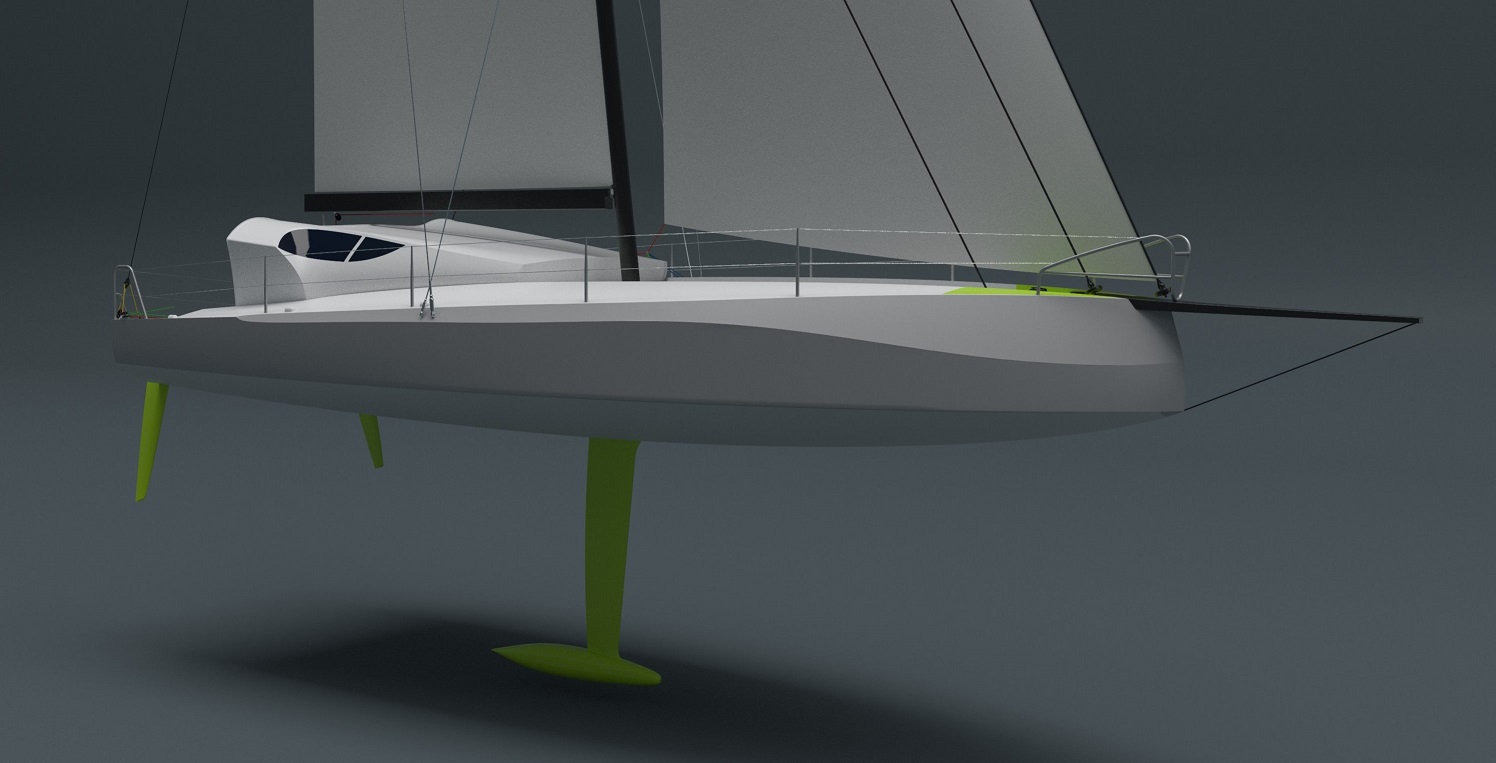
Since those early days, OC has continued to be a leader in the class with eighteen boats delivered, all to private owners and still competing across the globe. In a class with incredibly close racing, reliability and polyvalent design has proven to deliver an edge in race after race.
Given our history with the class that stretches back to the very beginning, we are proud to announce that construction is well underway on a new, sixth generation design. Commissioned by Michael Hennessy, American skipper of the legendary #54 Dragon, this new OC scow design is intended to take on the best of the Class40 fleet on both sides of the Atlantic.
Owen Clarke, working with Peter Hobson Design (PHD) and PURE Engineering have come up with the fastest, most versatile Class40 drawn to date. Merf Owen, principal designer, explains: “after a close review of the existing scow bow fleet, we identified key design features that contribute to success and as importantly, those that do not. In 2022 alone we subjected 86 different hulls to CFD analysis and VPP testing against computer models of our competitor’s designs, on the classic ocean racing courses using historical weather data. We are highly confident that the boat can reach the top of the podium across a wide range of courses and conditions”.
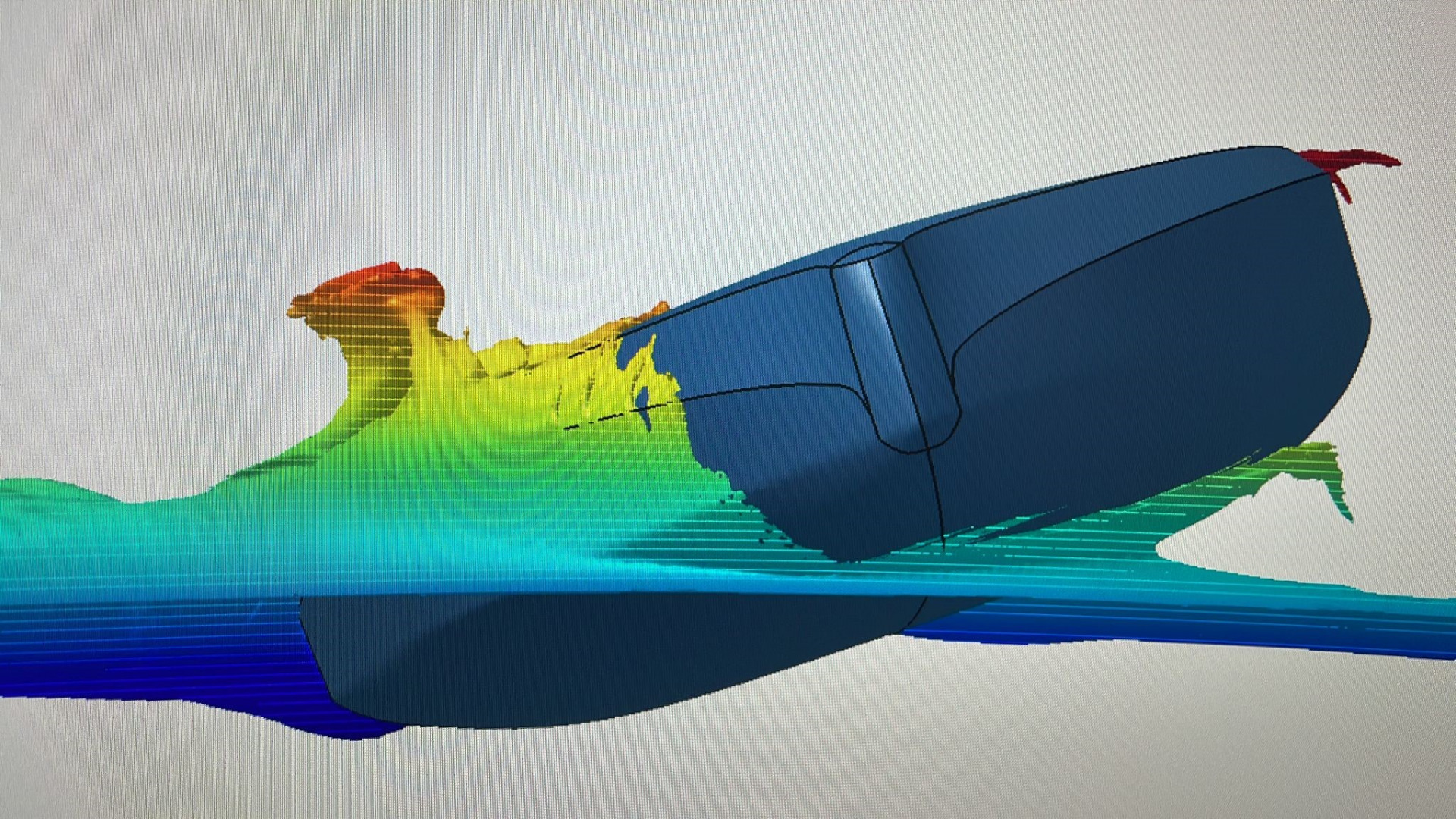
The design team also worked closely with Hennessy to focus on skipper ergonomics, designing a cabin, cockpit and deck that are meant to provide unparalleled protection for its crew and ensuring that they can sail at peak efficiency for transoceanic races. Leaning on his own ocean racing experience, Merf reflected “a fast boat is better able to achieve its potential if the crew can perform at 100%. Hennessy adds: “I strongly believe we’ve been able to ensure this new design supports a better ergonomic outcome than any other boat in the Class40.”
Evolution Marine in Cape Town has been engaged to build the new boat. Their experienced team, led by Oliver Dawson, has already built the hull and deck tooling and is busy laminating structure. She will be delivered from South Africa to France for final fit out by Marco Lefevre and his Class40 specialists at V1D2 in March of 2023, and will be raced in Europe next season against the best of the Class40 fleet.
For more information about Owen Clarke’s new scow Class40, please contact [email protected]

- CLASSIFIEDS
- NEWSLETTERS
- SUBMIT NEWS

The newest fast 30, by Farr
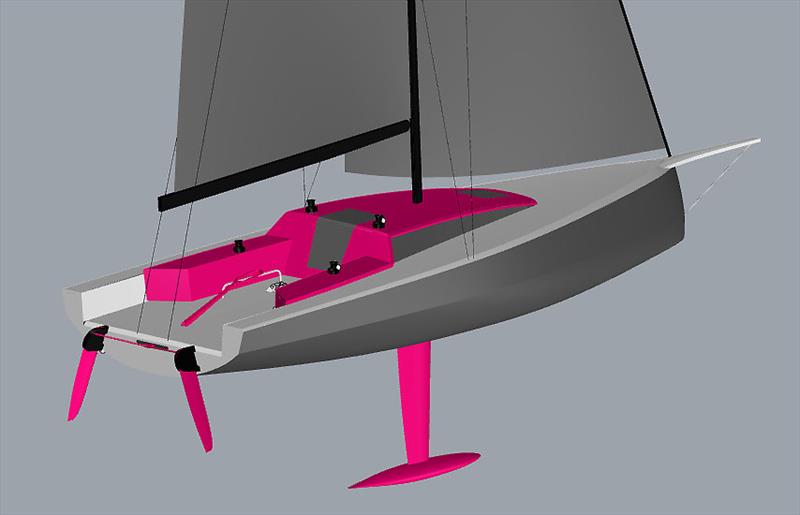
Related Articles
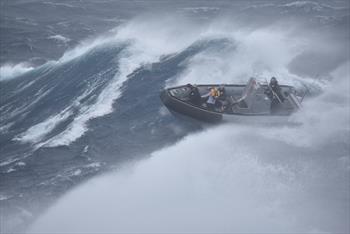
BoatNews.com
In project, a Scow for fast cruising
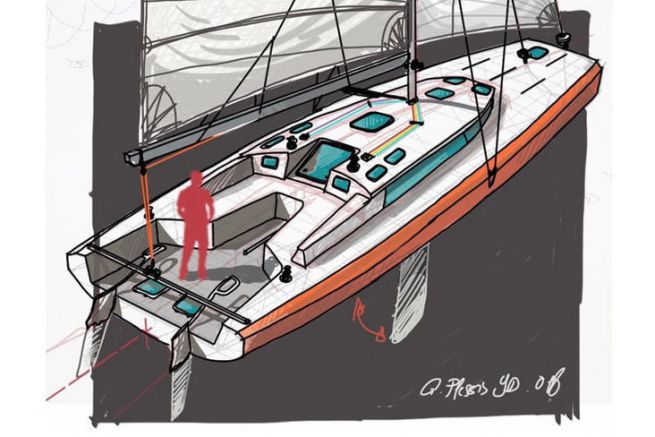
Gildas Plessis presents us his latest project for a fast cruising sailboat. A scow type hull with a round bow adapted for cruising. Built in composite, this sailboat has many advantages on paper. Now it remains to start construction.
Jean-Michel Linck is no stranger to the world of shipbuilding . Sailor and builder of many sailboats (Class 9.50, Mini 6.50 catamaran Fusioneuros), he has often worked with the architect Gildas Plessis. It is besides on one of his plans built in plywood that he left for a ballad around the Atlantic of more than 13000 Miles. It is during this journey, which he returned alone, that he had time to imagine his next "ideal" boat.
It will be the Sail SCOW 37, a fast cruising boat, a bit like what the Structure shipyard offers with the Pogo. Except that this time, the idea is to use the benefits of the round bow hull of the scow type.
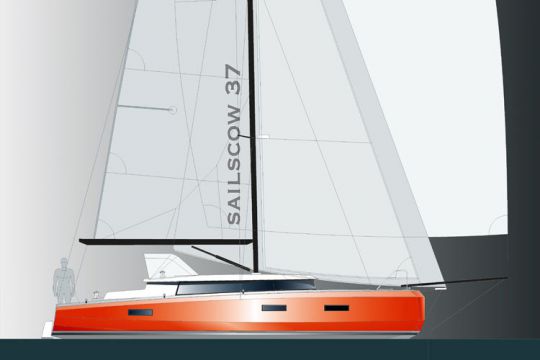
The Scow , a great idea!
According to Gildas Plessis who is the architect, the scow hull "is a great idea. Designing this type of boat comes at the right time. But we have to make something sexier than the productions currently proposed on the market. (Editor's note: Gildas Plessis is referring to the Revolution 29 built in aluminum by AFEP Marine). By increasing the level of tension in the lines and by improving the design, we can make a nice racing-cruising boat that is very livable.
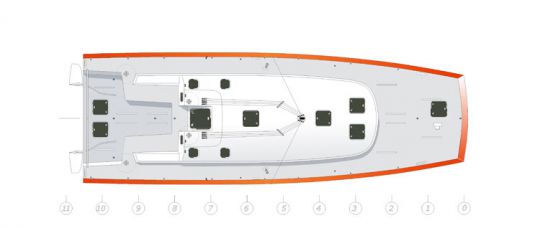
Volume in the front, but a reasonable beam
The first drawings that the architect shows us are indeed promising. The very wide bow is not really round, but looks more like the marotte of an Optimist. "Built as a sandwich, the boat will be light. But not too light, because you also need to keep the weight to go through the waves without stopping".
The volumes in the bow do not require building a sailboat that is too wide. The Sail SCOW 37 will be less wide than the competition. It will be equipped with a choice of a lifting keel or a fixed keel.
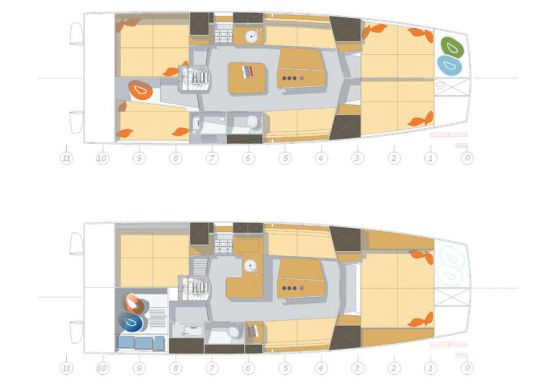
A 2 x 2 m bed!
In terms of layout, the round bow allows for all sorts of delusions: "We can put two real double cabins in the bow with beds of 140 x 200 in a yacht of less than 11 m! And in the owner's version, we can make a single huge cabin with a king size bed of 200 x 200!" The plans for this preliminary design propose from 2 to 4 cabins.
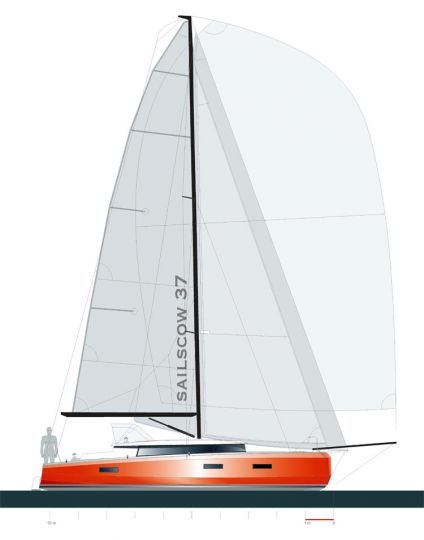
Faster at all speeds
As for the navigation, the architect does not hide the fact that "it will be difficult to sail well in short choppy seas upwind. But when cruising, we avoid this kind of condition if we can. Otherwise, in all other points of sail , the gain will be enormous. The Sail Scow will still sail above 10 knots with no problem."
An exciting project
You can tell by the sound of his voice, Gildas Plessis is enthusiastic about this project: "The Scow hull is an obvious choice for performance at sea and for cruising, because of its habitable volume. Now Jean-Michel Linck has to succeed in setting up the shipyard , finding financing and launching the construction. We hope that this boat will see the light of day, as it is so exciting on paper.
Sail SCOW 37
- Length : 10 M 80
- Bau hull : 3 m 80
- Estimated light weight : 3800 kg
- TE : keelboat 1,90 m
- TE QR : 1 m / 2,40 m
- Carbon rigging
- Upwind canopy : 96 m2
- Genoa : 57 m2
- Engine: 20 hp
- Construction: Epoxy glass sandwich
- 3 layout versions: from 2 cabins to 4 cabins
- Year of construction: 2019
- Architecture agency : G. Plessis YD
- Marketing and contact: Jean-Michel Linck - 07 67 41 93 60
Weather Forecast
2:00 pm, 06/12: -11°C - Partly Cloudy
2:00 am, 07/12: -4°C - Clear
2:00 pm, 07/12: -7°C - Partly Cloudy
2:00 am, 08/12: -3°C - Overcast
- Cruising Compass
- Multihulls Today
- Advertising & Rates
- Author Guidelines

British Builder Southerly Yachts Saved by New Owners

Introducing the New Twin-Keel, Deck Saloon Sirius 40DS

New 2024 Bavaria C50 Tour with Yacht Broker Ian Van Tuyl

Annapolis Sailboat Show 2023: 19 New Multihulls Previewed

2023 Newport International Boat Show Starts Today

Notes From the Annapolis Sailboat Show 2022


Energy Afloat: Lithium, Solar and Wind Are the Perfect Combination

Anatomy of a Tragedy at Sea

What if a Sailboat Hits a Whale?!?

Update on the Bitter End Yacht Club, Virgin Gorda, BVI

Charter in Puerto Rico. Enjoy Amazing Food, Music and Culture

With Charter Season Ahead, What’s Up in the BVI?

AIS Mystery: Ships Displaced and Strangely Circling

Holiday Sales. Garmin Marine Stuff up to 20% Off
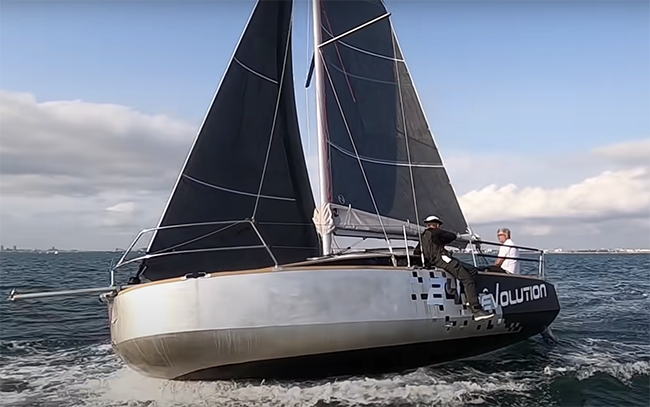
- Boat Reviews
Now for Something Completely Different: Revolution 24 Scow Bow
Watch Video
Author: Sandy Parks
Leave a reply cancel reply.

Published on October 11th, 2022 | by Editor
Scow bows rule the seas
Published on October 11th, 2022 by Editor -->
Class organizations such as the Mini 6.50, Class40, and IMOCA support offshore competition, and when courses are long enough, routing seeks out the benefits of offwind angles. Over time, designing to these class rules have developed hulls that may not go upwind too well but more than make up for it as the wind angles comes back.
Such as the scow bow.
Sam Manuard is a renowned architect in the scow world, and what began as a radical concept with the Mini Class, has seen its success trickle up to the Class40 and IMOCA which will be on full display in the 2022 Route du Rhum when it starts November 6.
These big bowed boats will be spanning the transatlantic from France to Guadeloupe, with the 3543nm course providing the latest test. Here are some comments from Manuard in boatsnews.com :

Regarding the state of design: Nowadays, everyone makes scows. There is no more debate on the subject. There are always nuances on the scow theme. Lombard with the Lift has made a very powerful boat, VPLP with the Clak40 which looks more versatile. It’s progressing well and the different designs are pretty close in performance. Everyone has raised their game.
Versatility versus all-around performance: We are interested in the statistical distribution of wind and speed for this type of race. We also look at races like the Fastnet, the Normandy Channel Race to have a boat that is efficient in light airs, that goes upwind well. Having a flat spectrum is quite interesting. In the design loop, the Mach5 (his latest design) has the Route du Rhum as its primary objective. But also the other races, not necessarily with the same level of priority. In any case, the choices made should be effective on all types of races.
But for an offwind race like the Route du Rhum… With an increasing number of scows, the classic (non-scow) boats no longer have a chance of winning.

Tags: boatsnews.com , Class40 , Route du Rhum , Sam Manuard
Related Posts
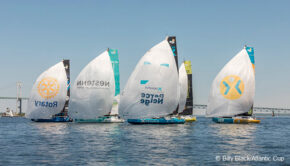
Leg 2 complete for Atlantic Cup →
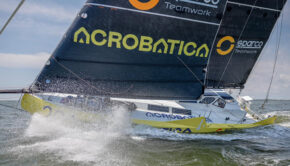
Leg 1 complete for Atlantic Cup →
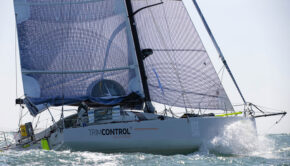
Countdown to 2024 Atlantic Cup →
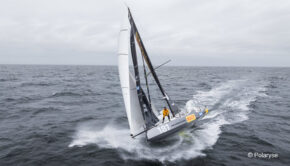
Italy wins Transat CIC Class 40 title →
© 2024 Scuttlebutt Sailing News. Inbox Communications, Inc. All Rights Reserved. made by VSSL Agency .
- Privacy Statement
- Advertise With Us
Get Your Sailing News Fix!
Your download by email.
- Your Name...
- Your Email... *
- Email This field is for validation purposes and should be left unchanged.

Log in or Sign up
You are using an out of date browser. It may not display this or other websites correctly. You should upgrade or use an alternative browser .
(Scow bow) - vs - (Wave piercing bow)
Discussion in ' Boat Design ' started by Gunnar Sommerlund , Jul 10, 2017 .
Gunnar Sommerlund Marine Engineer
Hello, this is my first time on this forum "i have been lurking around". <- (Bear with me) I haven't been able to find information regarding " differences " between scow and piercing bow types. I know that a sharp bow has a minimal wet surface, while scow i focused more about planning capabilities and is popular in lake sailing (in America). The reason i,m asking is because i have decided to spend next couple of years designing a sailboat in range of 25' to 30' foot. for sailing inshore waters of Denmark, and participating in local races now and then. The Scow seems to be gaining popularity (in mini transat) and i cant stop wondering why there arent more of them around. I have uploaded an example of arkemas mini transat and figaro 3 . I Absolutely love their designs. They are both made for open ocean right?
Doug Lord Flight Ready
The scow shape for Mini's began with David Raisons boat a few years ago and has proven to be very fast. The newest versions like Arkema and SeAir have taken another major leap in technology utilizing lifting foils to completely fly the boat. And two years ago Hugh Welbourn and Quant boats introduced the worlds first foiling keelboat scow the Quant 23.Very exciting times! The Quant 23 takes off in a 5 knot breeze and foils upwind in 7-8knots of wind. It uses a unique foil system that doesn't require constant adjustment and that drastically increases the righting moment of the boat. According to those that have sailed it ,it is very easy to learn to fly: SeAir Mini with Welbourn foil system:
Doug Lord said: ↑ The scow shape for Mini's began with David Raisons boat a few years ago and has proven to be very fast. The newest versions like Arkema and SeAir have taken another major leap in technology utilizing lifting foils to completely fly the boat. And two years ago Hugh Welbourn and Quant boats introduced the worlds first foiling keelboat scow the Quant 23.Very exciting times! The Quant 23 takes off in a 5 knot breeze and foils upwind in 7-8knots of wind. It uses a unique foil system that doesn't require constant adjustment and that drastically increases the righting moment of the boat. According to those that have sailed it ,it is very easy to learn to fly: View attachment 134445 SeAir Mini with Welbourn foil system: View attachment 134446 Click to expand...
Gunnar, I haven't sailed a Mini but while I think the new scows are amazing I think they are not pretty in the traditional sense. I guess it depends on what you want to do. I would consider using foil assist if not full flying. Good Luck!
gonzo Senior Member
The Mini Transat has developed boats specialized in downwind sailing. If that is what you are considering, the blunt bow and shape conducive to surfing is great. For an all around boat, it is not the best.
SamSam Senior Member
Here's an article in a "Yazi" magazine about bow types. On page 3 they discuss (a little bit) about the 2 types you're interested in. How to make a better yacht bow http://www.boatinternational.com/yachts/yacht-design/how-to-make-a-better-yacht-bow--799 You might try 'searching' in the various forums here. Also, usually at the bottom of the page of whatever you are looking at is a list of 'similar threads' which is an automatic search feature. Welcome.
gonzo said: ↑ The Mini Transat has developed boats specialized in downwind sailing. If that is what you are considering, the blunt bow and shape conducive to surfing is great. For an all around boat, it is not the best. Click to expand...
Search Results for Query: piercing bows | Boat Design Net https://www.boatdesign.net/content-search/92268/?q=piercing+bows&t=post&o=date Search Results for Query: scow bows | Boat Design Net https://www.boatdesign.net/content-search/92270/?q=scow+bows&t=post&o=date
Gunnar Sommerlund said: ↑ That is good to know. Becouse i,m looking for a design that preforms well inshore. Coastal cruising no more then 20 miles from shore. Click to expand...
Thank you guys for the links. I will lurk arround and post what crazy ideas i come up with =)
CT249 Senior Member
One issue is that one of the big benefits of the scow is that they increase righting moment, but often at the expense of extra wetted surface and wave drag as I understand it. The extra righting moment is more of a plus if you have a big rig, and the extra drag is less of a problem if you have a big rig and a significant problem if you have a small one. So you tend to see scow bows on boats with big rigs. In some ways, something like a 25 foot scow is often simply a 28 foot boat with the bow chopped off; in fact in some small boat classes where there was a length restriction and big rigs, designers just used to design a longer boat and then effectively chop the bow off at the desired length. So you had 14 foot "snub bow" boats that were effectively 16 footers with the front cut off. It may just underline how designing a boat to a set overall length is actually quite artificial in some ways. A 22' scow would often become a better boat for minimal extra cost if you added with 3' of pointy nose onto it. Which leaves one to wonder where the advantage is, if one is not limited by LOA.
Scows, like the inland lake scows in the US and even the Mini scows are designed to sail at an angle of heel that reduces wetted surface and changes how the bow interacts with waves. You can see how much the wetted surface is reduced with the right angle of heel in the pictures below:
PAR Yacht Designer/Builder
The advantage of a scow hull form is the heeled waterline symmetricity, compaired to a more conventional canoe body. A a scow heels and as Doug points out, the typical canoe body's WL's tend to become very asymmetric with a strong rounding moment, yet the scow's WL's are less so and move dramatically to leeward, increasing the couple, but also decreasing resistance. Comparing a fine bow canoe body, particularly if fat butted for downwind efforts, to a scow just isn't a fair comparison. They're using different principles and hydrodynamic tricks to get their performance envelop. For inshore cruising and occasional racing, the more common triangular canoe body would be the reasonable choice. The scow is a fairly specialized hull form and you'll get dinged pretty hard, if you show up at the local 'round the buoys event, with a scow against a bunch of canoe sloops. Lastly, the scow hull form isn't the best choice for a cruiser, IMO, just no internal volume, which is high on the priority list in a cruiser.
Paul, when you compare a "Mini" scow hull with another 21-22 footer the Mini has a ton of internal volume but the 28' E scow sure doesn't-like you said.
- Advertisement:
PAR said: ↑ The advantage of a scow hull form is the heeled waterline symmetricity, compaired to a more conventional canoe body. A a scow heels and as Dog points out, the typical canoe body's WL's tend to become very asymmetric with a strong rounding moment, yet the scow's WL's are less so and move dramatically to leeward, increasing the couple, but also decreasing resistance. Comparing a fine bow canoe body, particularly if fat butted for downwind efforts, to a scow just isn't a fair comparison. They're using different principles and hydrodynamic tricks to get their performance envelop. For inshore cruising and occasional racing the more common triangular canoe body would be the reasonable choice. The scow is a fairly specialized hull form and you'll get dinged pretty hard, if you show up at the local 'round the buoys event, with a scow against a bunch of canoe sloops. Lastly, the scow hull form isn't the best choice for a cruise, IMO, just no internal volume, which is high on the priority list in a cruiser. Click to expand...
- No, create an account now.
- Yes, my password is:
- Forgot your password?

Yachting World
- Digital Edition

Ugly – but fast?
- Elaine Bunting
- April 16, 2012
The latest hot trend in ocean racing design is the scow bow. But it's ugly and it looks as if it'd be brutal upwind

I’m torn when I think about the latest trend for ocean racing, the scow bow. On the one hand, it’s a fascinating development. On the other…cripes, these new designs are ugly.
Round bowed scows have been well proven; the skimming dish designs have long been popular in the US, though less so in Europe. Yet the design principle made no major inroads into offshore design until last year, when French engineer and solo sailor David Raison won the Mini Transat in his self-designed mini 6.5m Mini Magnum/Teamwork Evolution.
This round bowed, push-me-pull-you 21-footer beat the 2nd placed prototype Mini to the finish in Brazil by 130 miles – a huge margin in such an evenly matched fleet – and recorded an average across the entire Atlantic of 6.8 knots.
He nicknamed his wide-bodied design ‘le gros porteur’, the jumbo jet, in reference to its max beam, carried as far forward as possible.
Now there is a proposal from design group Reichel/Pugh for a 90ft scow (pictured above) designed to attempt to beat the Transpac record. We’ve got a full report on this intriguing design in our May issue.
The basic principle of the scow design is to maximise hull righting moment. The beam is carried well forward which means that, when heeled, the hull lines are further outboard than with a conventional bow. This makes the scow design very powerful when reaching, obviously important on races such as the Mini Transat or the Transpac, which have a predominance of reaching conditions.
It has the added advanced advantage of large reserve buoyancy in the bow to prevent the bow from burying or nosediving when driven hard off the wind.
Put that together with a canting keel, as is the case on David Raison’s boat, and you have a potentially very powerful yacht indeed.
However there are two snags with this design.
The first is that, upwind, the rounded bow slams, even when well heeled. This means it may not be that versatile a design or particularly comfortable in all-round conditions.
And in view of what are seeing in the Volvo Ocean race, which has suffered multiple structural problems in the harsh seas of the Southern Ocean, it would be a very brave designer (and sponsor) indeed that plumped for a scow design round the world or more general racing conditions.
Secondly, let’s face it: these two new extreme scow designs are not pretty. Would you want a yacht that looked like this? I wouldn’t. If your boat was jarring as this, you’d have to win.
But since Raison’s dramatic victory, I suspect designers everywhere have been playing around with the scow idea. In classes whose rules don’t place a restriction on maximum righting moment, it’s an obvious idea to explore. If it takes off, clever minds may even find some creative ways of softening the brutal front end.
Expedia Rewards is now One Key™
Elektrostal, visit elektrostal, check elektrostal hotel availability, popular places to visit.
- Electrostal History and Art Museum
You can spend time exploring the galleries in Electrostal History and Art Museum in Elektrostal. Take in the museums while you're in the area.
- Cities near Elektrostal

- Places of interest
- Yuri Gagarin Cosmonaut Training Center
- Central Museum of the Air Forces at Monino
- Peter the Great Military Academy
- Bykovo Manor
- Balashikha Arena
- Balashikha Museum of History and Local Lore
- Pekhorka Park
- Ramenskii History and Art Museum
- Orekhovo Zuevsky City Exhibition Hall
- Malenky Puppet Theater
- Noginsk Museum and Exhibition Center
- Saturn Stadium

- Bahasa Indonesia
- Eastern Europe
- Moscow Oblast
Elektrostal
Elektrostal Localisation : Country Russia , Oblast Moscow Oblast . Available Information : Geographical coordinates , Population, Area, Altitude, Weather and Hotel . Nearby cities and villages : Noginsk , Pavlovsky Posad and Staraya Kupavna .
Information
Find all the information of Elektrostal or click on the section of your choice in the left menu.
- Update data
| Country | |
|---|---|
| Oblast |
Elektrostal Demography
Information on the people and the population of Elektrostal.
| Elektrostal Population | 157,409 inhabitants |
|---|---|
| Elektrostal Population Density | 3,179.3 /km² (8,234.4 /sq mi) |
Elektrostal Geography
Geographic Information regarding City of Elektrostal .
| Elektrostal Geographical coordinates | Latitude: , Longitude: 55° 48′ 0″ North, 38° 27′ 0″ East |
|---|---|
| Elektrostal Area | 4,951 hectares 49.51 km² (19.12 sq mi) |
| Elektrostal Altitude | 164 m (538 ft) |
| Elektrostal Climate | Humid continental climate (Köppen climate classification: Dfb) |
Elektrostal Distance
Distance (in kilometers) between Elektrostal and the biggest cities of Russia.
Elektrostal Map
Locate simply the city of Elektrostal through the card, map and satellite image of the city.
Elektrostal Nearby cities and villages
Elektrostal Weather
Weather forecast for the next coming days and current time of Elektrostal.
Elektrostal Sunrise and sunset
Find below the times of sunrise and sunset calculated 7 days to Elektrostal.
| Day | Sunrise and sunset | Twilight | Nautical twilight | Astronomical twilight |
|---|---|---|---|---|
| 8 July | 02:53 - 11:31 - 20:08 | 01:56 - 21:06 | 01:00 - 01:00 | 01:00 - 01:00 |
| 9 July | 02:55 - 11:31 - 20:08 | 01:57 - 21:05 | 01:00 - 01:00 | 01:00 - 01:00 |
| 10 July | 02:56 - 11:31 - 20:07 | 01:59 - 21:04 | 23:45 - 23:17 | 01:00 - 01:00 |
| 11 July | 02:57 - 11:31 - 20:05 | 02:01 - 21:02 | 23:57 - 23:06 | 01:00 - 01:00 |
| 12 July | 02:59 - 11:31 - 20:04 | 02:02 - 21:01 | 00:05 - 22:58 | 01:00 - 01:00 |
| 13 July | 03:00 - 11:32 - 20:03 | 02:04 - 20:59 | 00:12 - 22:51 | 01:00 - 01:00 |
| 14 July | 03:01 - 11:32 - 20:02 | 02:06 - 20:57 | 00:18 - 22:45 | 01:00 - 01:00 |
Elektrostal Hotel
Our team has selected for you a list of hotel in Elektrostal classified by value for money. Book your hotel room at the best price.
| Located next to Noginskoye Highway in Electrostal, Apelsin Hotel offers comfortable rooms with free Wi-Fi. Free parking is available. The elegant rooms are air conditioned and feature a flat-screen satellite TV and fridge... | from | |
| Located in the green area Yamskiye Woods, 5 km from Elektrostal city centre, this hotel features a sauna and a restaurant. It offers rooms with a kitchen... | from | |
| Ekotel Bogorodsk Hotel is located in a picturesque park near Chernogolovsky Pond. It features an indoor swimming pool and a wellness centre. Free Wi-Fi and private parking are provided... | from | |
| Surrounded by 420,000 m² of parkland and overlooking Kovershi Lake, this hotel outside Moscow offers spa and fitness facilities, and a private beach area with volleyball court and loungers... | from | |
| Surrounded by green parklands, this hotel in the Moscow region features 2 restaurants, a bowling alley with bar, and several spa and fitness facilities. Moscow Ring Road is 17 km away... | from | |
Elektrostal Nearby
Below is a list of activities and point of interest in Elektrostal and its surroundings.
Elektrostal Page
| Direct link | |
|---|---|
| DB-City.com | Elektrostal /5 (2021-10-07 13:22:50) |

- Information /Russian-Federation--Moscow-Oblast--Elektrostal#info
- Demography /Russian-Federation--Moscow-Oblast--Elektrostal#demo
- Geography /Russian-Federation--Moscow-Oblast--Elektrostal#geo
- Distance /Russian-Federation--Moscow-Oblast--Elektrostal#dist1
- Map /Russian-Federation--Moscow-Oblast--Elektrostal#map
- Nearby cities and villages /Russian-Federation--Moscow-Oblast--Elektrostal#dist2
- Weather /Russian-Federation--Moscow-Oblast--Elektrostal#weather
- Sunrise and sunset /Russian-Federation--Moscow-Oblast--Elektrostal#sun
- Hotel /Russian-Federation--Moscow-Oblast--Elektrostal#hotel
- Nearby /Russian-Federation--Moscow-Oblast--Elektrostal#around
- Page /Russian-Federation--Moscow-Oblast--Elektrostal#page
- Terms of Use
- Copyright © 2024 DB-City - All rights reserved
- Change Ad Consent Do not sell my data

IMAGES
VIDEO
COMMENTS
SailScow 37. Much of the drive towards scow bow cruising yachts is driven by top level racing sailors. Armel Tripon, who raced the then radical Sam Manuard-designed IMOCA 60 L'Occitane de ...
Much of the drive towards scow bow cruising yachts is driven by top level racing sailors. Armel Tripon, who raced the then radical Sam Manuard-designed IMOCA 60 L'Occitane en Provence in the ...
Revolution 24 : A successful version of the aluminum scow bow cruiser. AFEP, a small shipyard based in La Rochelle, was the first to adopt scow hulls for the cruising yachtsman. For its third model, it has found an interesting balance between design, performance and choice of materials. Presentation.
The Ace 30 is a new design intended to bring the scow bow concept, popular among offshore racing machines, to IRC yachts. TAGS: Extraordinary boats monohull Top stories. Scow bow designs are still ...
But putting a scow bow on a cruising boat obviously doesn't instantly make it a "cruiser-racer." What makes the scow bow super-competitive is that it facilitates a boat's ability to plane, and the other key factor in that equation is always weight.
The short answer is more righting moment, both across the boat and longitudinally. For a given overall beam and keel weight, a scow bow gives more volume away from the centreline as well as more volume ahead of the centre of gravity.
Owen Clarke are the designers of this new Open Class 40 with a scow bow design currently in build at Evolution Marine. This, their sixth generation Class 40 des
The modern hybrid-scow hull form provides many of the downwind advantages of the scow bow style craft, without sacrificing the boats performance to windward in waves."
Gildas Plessis presents us his latest project for a fast cruising sailboat. A scow type hull with a round bow adapted for cruising. Built in composite, this sailboat has many advantages on paper. Now it remains to start construction.
Now for Something Completely Different: Revolution 24 Scow Bow ... Watch Video
The scow-bowed Revolution 24 is certainly weird, but is it wonderful? This mini-cruiser may look quirky, even extraordinary, but wait till you see the space it provides below decks. Toby Hodges ...
The Caribbean 600 scow bow Class 40's were significantly faster than the pointy bows in variety of sailing conditions.
Scow bows rule the seas. Class organizations such as the Mini 6.50, Class40, and IMOCA support offshore competition, and when courses are long enough, routing seeks out the benefits of offwind ...
Recently, I've read up some interesting stuff about SCOW bow sailboats. There seem to be many advantages to this design. So why don't we see more of these types of sailboats? What are the negatives associated with this sailboat designs?
I know that a sharp bow has a minimal wet surface, while scow i focused more about planning capabilities and is popular in lake sailing (in America). The reason i,m asking is because i have decided to spend next couple of years designing a sailboat in range of 25' to 30' foot. for sailing inshore waters of Denmark, and participating in local ...
Horses for courses. A scow bow will be faster in longer distance races particularly where routing is employed to ensure that, to the greatest extent possible, they can be reaching and not pushing into a seaway. See "french stuff". In everyday club type racing where all round ability is at a...
Ugly - but fast? Elaine Bunting. April 16, 2012. 0 shares. The latest hot trend in ocean racing design is the scow bow. But it's ugly and it looks as if it'd be brutal upwind. I'm torn when I ...
您可以向此项目. Zhukovsky coat of arms. Date of adoption: April 25, 2002. Textual description: "On a sky-blue (azure) field there are three wide arrow-heads in a triangle (two and one in a form of a plane). Above them there're two wings. All figures in gold".
It appears that the AFEP company started life as an aluminium fabricator, but I guess we see in this thread the scow / sea shovel design lends it's shape well to glass, aluminum and even plywood. I'm sure the Dutch could make a fine one out of thin gauge/corrosion resistant alloy steel. EU based manufacturers are under more pressure to produce ...
Travel guide resource for your visit to Elektrostal. Discover the best of Elektrostal so you can plan your trip right.
State Housing Inspectorate of the Moscow Region is located in Elektrostal. State Housing Inspectorate of the Moscow Region is working in Public administration activities. You can contact the company at 8 (496) 575-02-20. You can find more information about State Housing Inspectorate of the Moscow Region at gzhi.mosreg.ru.
Elektrostal : Elektrostal Localisation : Country Russia, Oblast Moscow Oblast. Available Information : Geographical coordinates, Population, Area, Altitude, Weather and Hotel. Nearby cities and villages : Noginsk, Pavlovsky Posad and Staraya Kupavna. - City, Town and Village of the world